

Tech and Transliteracy. "Re: Your Brains" in ASL. Jonathan Coulton on YouTube. Jonathan Coulton's transmedia. If you’ve made it this far, congratulations: you are on your way to becoming an official JoCo fan first class.

You may be interested in some of these interesting things – basically more ways to give me money, get involved, and in general suck the marrow out of your burgeoning JoCo fandom. Live Shows Future Shows – a list of what’s coming up.Mailing List – sign up here and you’ll never miss another show. I promise I won’t flood your inbox, most of the time I just send show updates once or twice a month. Transliteracy. Transliteracy (pl. transliteracies) is the ability to understand and communicate—to be "literate"—across all communications platforms, from sign language and speaking, to reading and writing, to the mass media, to digital communication and social networking.
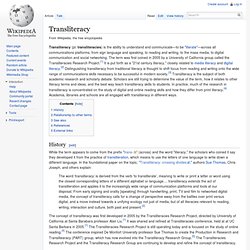
The term was first coined in 2005 by a University of California group called the Transliteracies Research Project.[1] It is put forth as a "21st century literacy," closely related to media literacy and digital literacy.[2] Distinguishing transliteracy from traditional literacy is thought to shift focus from reading and writing onto the wide range of communications skills necessary to be successful in modern society.[3] Transliteracy is the subject of both academic research and scholarly debate. Scholars are still trying to determine the value of the term, how it relates to other literacy terms and ideas, and the best way teach transliteracy skills to students. History[edit] Relationship to other terms[edit] See also[edit] Annette Lamb's Transmedia. Watch the Portlandia Technology Loop ideo. iPhone, iTouch, iPad, Kindles, Nooks, GPS devices, laptops, books, augmented reality headsets... we're experiencing a wave of technology.

It's easy to get overwhelmed by the choices. Transmedia... readers seamlessly move from technology to technology experiencing and participating in the story. Examples of transmedia include The 39 Clues, Skeleton Creek, and Cathy's Series. Even J.K. Transmedia storytelling. "Transmedia" redirects here.
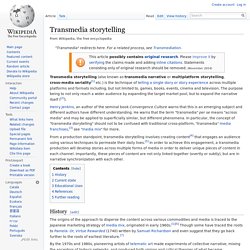
For a related process, see Transmediation. Transmedia storytelling (also known as transmedia narrative or multiplatform storytelling, cross-media seriality[1] etc.) is the technique of telling a single story or story experience across multiple platforms and formats including, but not limited to, games, books, events, cinema and television.
The purpose being to not only reach a wider audience by expanding the target market pool, but to expand the narrative itself ([2]). Storytelling 2.0. Richard Fisher, features editor Good storytellers are adept at pulling people into their tales with enthralling character development and captivating plot.

But what happens in our brains when we are absorbed in a good book or movie? That feeling of immersion may signify more than we realise. The Secrets of Storytelling. When Brad Pitt tells Eric Bana in the 2004 film Troy that “there are no pacts between lions and men,” he is not reciting a clever line from the pen of a Hollywood screenwriter.
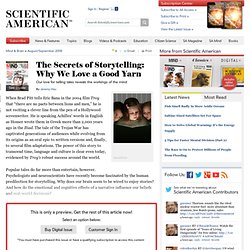
He is speaking Achilles’ words in English as Homer wrote them in Greek more than 2,000 years ago in the Iliad. The tale of the Trojan War has captivated generations of audiences while evolving from its origins as an oral epic to written versions and, finally, to several film adaptations. The power of this story to transcend time, language and culture is clear even today, evidenced by Troy’s robust success around the world. Popular tales do far more than entertain, however. Science Explains Why We're Hardwired for Stories. January 14th, 2012 · No Comments · Storytelling The best presentations usually come in the form of stories in disguise, but what is it about narrative that attracts us?
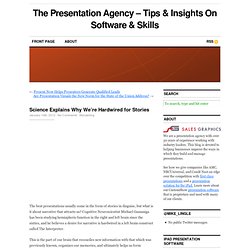
Cognitive Neuroscientist Michael Gazzaniga has been studying hemispheric function in the right and left brain since the sixties, and he believes a desire for narrative is hardwired in a left brain construct called The Interpreter. The dark side: Science of Propaganda. Mark Twain once tried to distinguish between the storyteller’s art and tales that a machine could generate.

He observed that stringing “incongruities and absurdities together in a wandering and sometimes purposeless way, and seem innocently unaware that they are absurdities,” was the province of the American storyteller. A machine might imitate simple formulas behind yarns, but never quite master them. The Pentagon’s freewheeling research arm is hoping to prove Twain wrong. Darpa is asking scientists to “take narratives and make them quantitatively analyzable in a rigorous, transparent and repeatable fashion.” The idea is to detect terrorists who have been indoctrinated by propaganda. Signs (2002. Conspiracy Theory (1997. Enemy of the State (1998. Sue Thomas: Transliteracy on Scoop.it. Buffy Hamilton on Transliteracy and Inquiry. Deborah Brandt: Literacy as a Social Practice. Pam Allyn - professional bio. Pam Allyn (born January 31, 1963) is an American literacy expert and author.
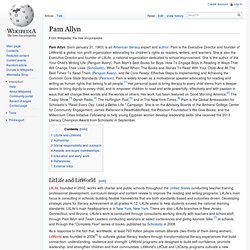
Pam is the Executive Director and founder of LitWorld, a global non-profit organization advocating for children’s rights as readers, writers, and learners. She is also the Executive Director and founder of LitLife, a national organization dedicated to school improvement. Bobbi Newman: Libraries and Transliteracy. Kate Pullinger: librarians arguing about transliteracy. This year conversation about transliteracy has really taken off amongst North American librarians.

Lane Wilkinson: Reorganizing literacy. Approximately forever ago (that’s March 30 in social media years), I got pretty tired of a certain argument bouncing around the pipes. On the one side, you have the transliteracy early adopters, insisting that transliteracy is a unifying framework covering all types of literacy. On the other side, you have the information literacy purists, insisting that transliteracy is a silly buzzword because, lest we forget, information literacy already covers all types of literacy. The problem is that it isn’t entirely clear that “all” types of literacy are even in the same category.
To the transliteracy folk, I wanted to ask: what does it mean to move across literacies, anyway? How do you move between print literacy, health literacy, and critical literacy, for example. The Partnership for 21st Century Skills on the 4Cs. Gradual release of responsibility. Transliteracy as Evaluation. Transliteracy is concerned with integrating, mapping, and evaluating informational meaning between and across different digital and print formats and media and NOT about developing literacies in various and individual digital and print formats and media. NETS standards. I Love Lucy #145. Larry Ferlazzo on I love Lucy. I put out a request, as I do every year, to readers to share the best education-related books that they had read over the past year.
The books could have been published earlier and the only requirement was that you had read them sometime this year. You might also be interested in these posts from previous years: The Best Education-Related Books Visitors To This Blog Read In 2011 The Best Education-Related Books Visitors To This Blog Read In 2010 The Best Education-Related Books Visitors To This Blog Read In 2009 The Best Education-Related Books Visitors To This Blog Read In 2008. Your Life Is A Transmedia Experience. Social-Creature. Meet the Zombie Invasion.
COLLABORATION tools. COMMUNICATION tools. CURATION tools. Transmedia Examples. Sqirlz Morph. SQIRLZ MORPH TUTORIAL.